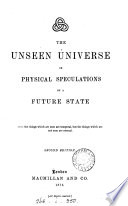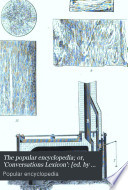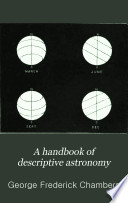 | Balfour Stewart - 1875 - 270 pages
...proportional to the times of description ; while the squares of the periodic times of the various planets are proportional to the cubes of their mean distances from the sun. These are Kepler's laws ; they are yet, however, only empirical. We know them to be true, but we cannot... | |
 | Popular encyclopedia - 1875 - 532 pages
...The squares of the periodic times (the periods of complete revolution round the sun) of two planets are proportional to the cubes of their mean distances from the sun. These laws were discovered from calculations on Tycho Brahe's observations; they enabled Newton to... | |
 | Balfour Stewart - 1875 - 244 pages
...proportional to the times of description ; while the squares of the periodic times of the various planets are proportional to the cubes of their mean distances from the sun. These are Kepler's laws ; they are yet, however, only empirical. We know them to be true, but we cannot... | |
 | Joel Dorman Steele - 1876 - 348 pages
...patience triumphed, and he reached the third law — THE SQUARES OP THE TIMES OF REVOLUTION OF THE PLANETS ABOUT THE SUN, ARE PROPORTIONAL TO THE CUBES OF THEIR MEAN DISTANCES FROM THE SUN.* In rapture over the discovery of these three laws, so marked by that divine simplicity which pervades... | |
 | George Frederick Chambers - 1877 - 968 pages
...each planet describes equal areas in equal times. 3. The squares of the periodic times of the planets are proportional to the cubes of their mean distances from the Sun. These laws hold good for all the planets and all their satellites. I have already referred in general... | |
 | John Adam Weisse - 1878 - 828 pages
...describes or passes over equal areas in equal times. 3. The squares of the periodic times of planets are proportional to the cubes of their mean distances from the sun. Of them Sir John Herschel says : " These laws constitute the most important and beautiful system of... | |
 | Royal Society of South Africa - 1878 - 922 pages
...planetary motion, one of which says: — "The squares of the times of the revolutions of the planets are proportional to the cubes of their mean distances from the sun." That is to say, there is a fixed relation between the mean distances of the planets from the sun and... | |
 | National cyclopaedia - 1879 - 668 pages
...occupied in its description. And 3. That the squares of the times of the revolutions of the planets are proportional to the cubes of their mean distances from the sun. This latter was discovered bv Kepler in 1618. KEPl'EL, AUGUSTUS, VISCOUNT, a gallant and able English admiral,... | |
 | 1880 - 1054 pages
...equal areas are described in equal times. 3d. That the squares of the periodic times of the planets are proportional to the cubes of their mean distances from the sun. Kerfe. The notch or slit made in cutting or sawing timber. Kerguelen's Land, or Island of Desolation.... | |
 | 1880 - 892 pages
...planetary motion, one of which says: — "The squares of the times of the revolutions of the planets are proportional to the cubes of their mean distances from the sun." That is to say, there is a fixed relation between the mean distances of the planets from the "m and... | |
| |